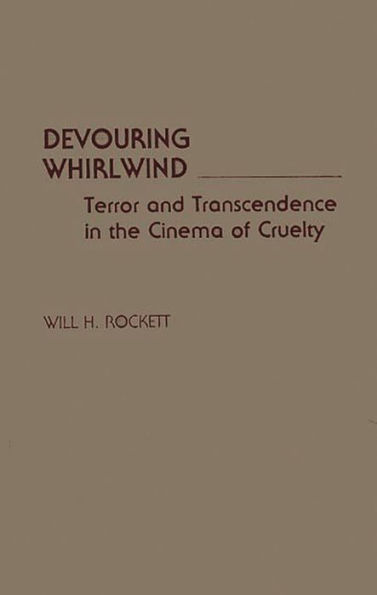Devouring Whirlwind: Terror and Transcendence in the Cinema of Cruelty
As the popularity of the genre increases and special effects are pushed to greater extremes of terror and cruelty, more and more people have begun to wonder, what is the attraction of horror films? Do they have any socially redeeming features? Rockett offers some surprising and provocative answers to these questions in his analysis of the cinema of cruelty. First commenting on our fascination with experiences that transcend the world of ordinary reality, he looks at film as a means of expressing the dark side of human nature. Next, he examines the essential ingredients that go into the making of a horror film, the variations that are found within the genre, and the links between the best horror cinema and Artaud's Theatre of Cruelty. Echoing Artaud, Rockett argues that human beings are attracted to horror in films because of an unconscious craving for a reality in which the demonic supernatural acts as a living whirlwind, devouring the darkness and bringing viewers closer to the transcendence they are actually seeking. The final chapter shows how the finest works in the horror genre achieve this underlying aim. He discusses filmmakers such as Roman Polanski, who have been able to provide the realism and artistic quality that contemporary audiences demand while preserving the ambiguity and terror necessary to experience the power of transcendent force. Rockett's skillful and imaginative exploration of the subject will be appreciated by scholars and general readers concerned with popular culture, film, literature, drama, and contemporary social issues.
1132776759
Devouring Whirlwind: Terror and Transcendence in the Cinema of Cruelty
As the popularity of the genre increases and special effects are pushed to greater extremes of terror and cruelty, more and more people have begun to wonder, what is the attraction of horror films? Do they have any socially redeeming features? Rockett offers some surprising and provocative answers to these questions in his analysis of the cinema of cruelty. First commenting on our fascination with experiences that transcend the world of ordinary reality, he looks at film as a means of expressing the dark side of human nature. Next, he examines the essential ingredients that go into the making of a horror film, the variations that are found within the genre, and the links between the best horror cinema and Artaud's Theatre of Cruelty. Echoing Artaud, Rockett argues that human beings are attracted to horror in films because of an unconscious craving for a reality in which the demonic supernatural acts as a living whirlwind, devouring the darkness and bringing viewers closer to the transcendence they are actually seeking. The final chapter shows how the finest works in the horror genre achieve this underlying aim. He discusses filmmakers such as Roman Polanski, who have been able to provide the realism and artistic quality that contemporary audiences demand while preserving the ambiguity and terror necessary to experience the power of transcendent force. Rockett's skillful and imaginative exploration of the subject will be appreciated by scholars and general readers concerned with popular culture, film, literature, drama, and contemporary social issues.
95.0
In Stock
5
1

Devouring Whirlwind: Terror and Transcendence in the Cinema of Cruelty
224
Devouring Whirlwind: Terror and Transcendence in the Cinema of Cruelty
224Hardcover
$95.00
95.0
In Stock

Product Details
| ISBN-13: | 9780313259982 |
|---|---|
| Publisher: | Bloomsbury Academic |
| Publication date: | 11/17/1988 |
| Series: | Contributions to the Study of Popular Culture , #21 |
| Pages: | 224 |
| Product dimensions: | 6.14(w) x 9.21(h) x 0.56(d) |
About the Author
From the B&N Reads Blog
